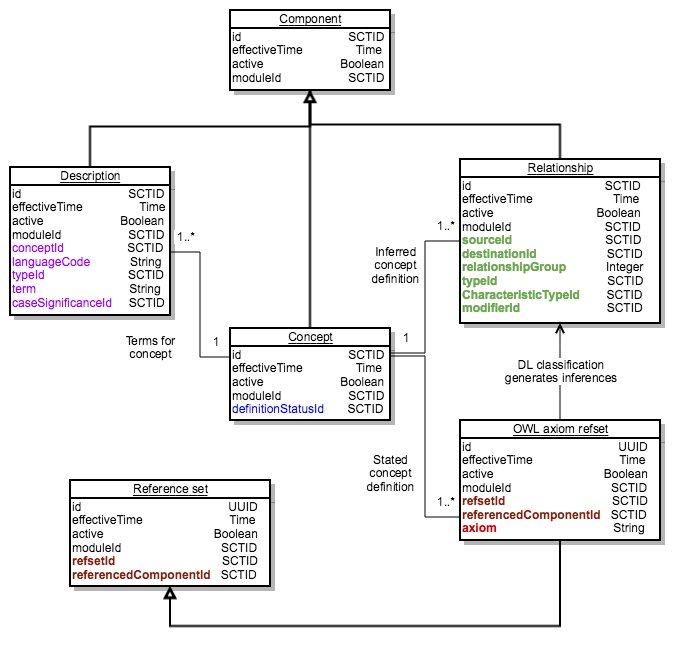This section outlines the rationale for distributing an OWL representation of the stated view of concept definitions and provides an overview of the way OWL axioms are represented in SNOMED CT release files. More detailed information is published separately in the SNOMED CT OWL Guide and the SNOMED CT Logic Profile Specification.
Rationale for Using OWL
The mismatch between the requirements for representing enhanced concept definitions and the capabilities of the current stated relationship file might in theory be addressed by addition of columns to the file or adding additional information in reference sets. However, in practice this would create a more complex solution able to support a specific set of enhanced features.
Adopting the well-established OWL standards formats offers a more flexible solution that can represent the full range of description logic features. This approach enables SNOMED Internation to specify a particular logic profile to be applied to current releases of SNOMED CT, with the option to extend that profile in the future. Future revisions of the logic profile would not require a change in the distribution file structure provided these were supported by an OWL syntax.
OWL Axioms
OWL axioms can be represented using several different syntaxes. SNOMED International has chose the OWL Functional Syntax as its standard representation.
The OWL Functional Syntax is
a formal representation of the web ontology language (OWL) as a simple text base syntax that is used as a bridge between the structural specification and various concrete syntaxes.
Related Links
OWL Expression Axiom Set
OWL axioms are distributed in a reference set that follows the OWL Expression Reference Set specification. The axiom itself is contained in a string field and the concept whose definition it contributes to is referenced by the the referencedComponentId. Although a single row in the reference set can provide a sufficient definition, the definition of a single concept can also include several axioms each represented by a row in the reference set.
Comparing Stated Relationships and OWL Axioms
Figure 2.3.4.2-1: Diagrammatic representation of the definition of appendectomy
Figure 2.3.4.2-1 shows the diagrammatic representation of the stated view of the definition of 80146002 | Appendectomy| . Table 2.3.4.2-1 shows the same definition as represented by three rows in the stated relationship file together with the definitionStatusId in the concept file.Table 2.3.4.2-1: Stated relationships and definition status for the concept appendectomy
id | effectiveTime | active | .. | definitionStatusId |
20020131 | 1 | .. |
id | effective Time | active | .. | sourceId | destinationId | relationship Group | typeId | .. | .. |
.. | 20180731 | 1 | .. | 0 | .. | .. | |||
.. | 20080731 | 1 | .. | 1 | .. | .. | |||
.. | 20080731 | 1 | .. | 1 | .. | .. |
Table 2.3.4.2-2 shows a row in the OWL axiom reference set file representing the same definition. As shown by this example, a single sufficient definition is represented by a single row in the reference set. However, some concept definitions may require multiple rows in the reference set. Situations in which multiple row are required include:
- Concepts with multiple sufficient definitions, each of which requires a separate row in the reference set.
- Concepts with additional necessary conditions that are not part of a sufficient definition, each of which requires a separate row in the reference set.
Table 2.3.4.2-2: Example of OWL axiom refset representation of the definition of appendectomy
id | effective Time | active | moduleId | refsetId | referenceComponentId | owlExpression |
.. | 1 | .. | EquivalentClasses(:80146002 ObjectIntersectionOf(:71388002 ObjectSomeValuesFrom(:609096000 ObjectIntersectionOf(ObjectSomeValuesFrom(:260686004 :129304002) ObjectSomeValuesFrom(:405813007 :66754008))))) |
Feedback

